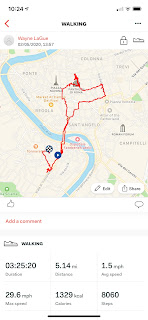 |
| Inside the Pantheon |
The interior of the Pantheon is beyond amazing. The shear space and perfect geometric dimensions constructed 113-125 AD astounds me. I can't even construct a decent frame with power tools. Jane described in detail how the Pantheon was built, particularly explaining the use of materials in the dome's construction. Inside, she led us around the perimeter to each chapel, my favorite being the tomb of Raphael.
On the way home we sought out a small fountain, The Water Bearer. The Visigoths destroyed the aqueducts during their 410 invasion, knowing the city could not survive without that water source. Subsequently, water bearers would gather water from the Tiber and sell it throughout the city. During the Renaissance the aqueducts were rebuilt to supply all the fabulous new fountains. This put the water bearers out of business. The fountain was created as a remembrance to these men. It is one of the 'talking' statues of Rome wherein people would post anonymous political expressions.
Our attempt at a home cooked fettuccine carbonara was, well, not so good. We shall try again, though. Pics at Flickr.
